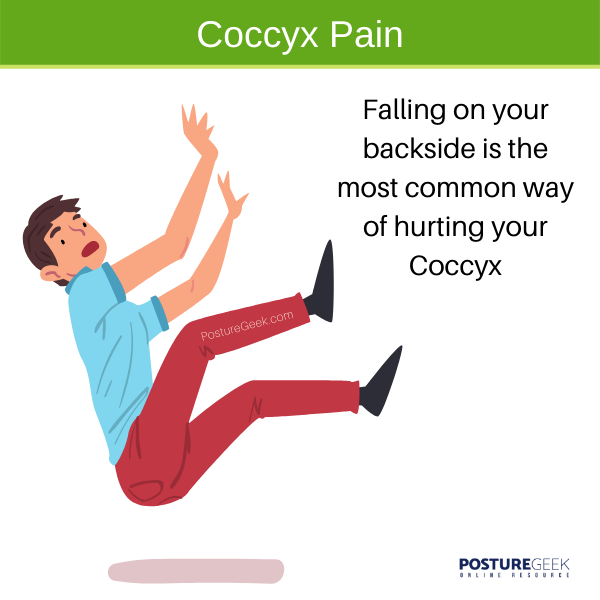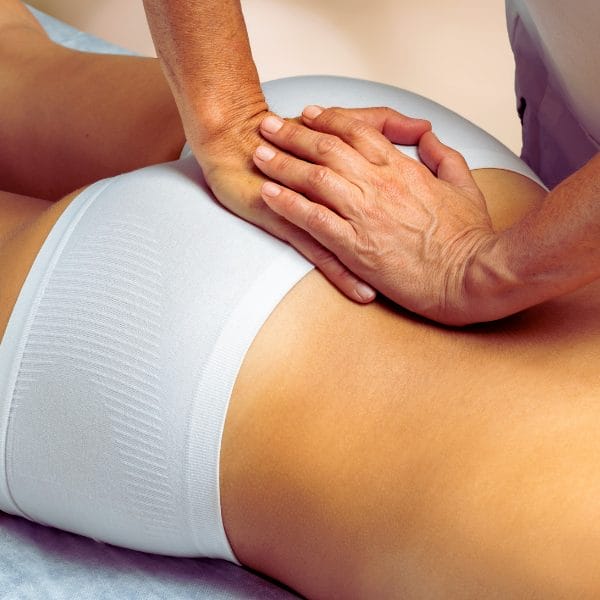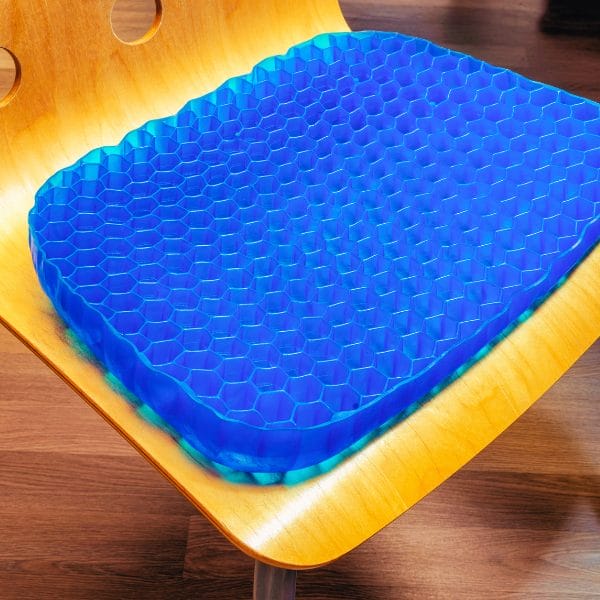Coccyx Pain: How Hurting Your Coccyx Can Make It Difficult to Sit, Stand, and Walk

Coccyx injuries are ones we don’t often hear about, but they can be extremely painful and challenging to deal with. The coccyx (commonly called the tailbone) is the small, triangle-shaped bone at the bottom of your spine, and an injury to this bone can make it difficult to sit, stand, or walk.
There are various reasons why someone might suffer a coccyx injury. Still, one of the most common is falling and landing on your backside. This can happen during multiple activities, such as sports, horseback riding, or even just slipping on a wet surface.
Treatment for a coccyx injury typically involves pain medication and rest, but surgery may be necessary in some cases. Here’s everything you need to know about coccyx injuries and how to treat them.
Anatomy of the Coccyx?

The coccyx is the small, triangle-shaped bone at the bottom of your spine. The coccyx comprises 3-5 small fused bones (depending on whether they’re fully developed). The coccyx is located at the bottom of your spine (attached to the Sacrum), just above your buttocks.
Because of its location and shape, the coccyx acts as a support structure for your body when sitting down.
Your coccyx doesn’t have a specific function, but it does provide support and stability for your pelvis. It also acts as an attachment point for your lower back and buttocks muscles, ligaments, and tendons.
Causes of Coccyx Pain
There are several reasons someone might suffer a coccyx injury. Still, the most common cause is falling and landing on your backside. This can happen during any number of activities, such as sports, horseback riding, or even slipping on a wet surface. Other causes of coccyx injuries include:
- Direct trauma to the area, such as from a car accident or fall: Can cause the coccyx to fracture or dislocate.
- Childbirth: The pressure of pushing a baby out can sometimes injure the coccyx.
- Sitting for too long: This can put pressure on the coccyx and lead to inflammation or pain.
- Degenerative conditions: As we age, the bones in our body can start to degenerate, and this can lead to coccyx pain.
- Obesity: This can put extra pressure on the coccyx, potentially causing it to move away from its natural resting state. Which has the potential to lead to coccyx pain.
- Spinal deformities: Conditions like scoliosis can put extra pressure on the coccyx and lead to pain.
- Tumor: In rare cases, a tumor can develop on the coccyx, which can cause pain.
Symptoms of a Coccyx Injury
The most common symptom of a coccyx injury is a pain in the tailbone area (or coccydynia pain). This pain can range from mild to severe, making it challenging to sit, stand, or walk. Other symptoms include:
- Bruising or swelling in the tailbone area: This can sometimes be seen in the case of a fracture.
- Numbness or tingling in the tailbone area: This is often caused by pressure on the nerves in the area.
- Difficulty sitting: The more severe pain can make it hard to find a comfortable sitting position, and you may have to adjust your position constantly.
- Feel the pain with bowel movements: This can signify an anal fissure, a tear in the tissue around the anus.
- Numbness or tingling in the legs: This is often caused by pressure on the nerves in the area.
How a Coccyx Injury Makes It Difficult to Sit
When you have a coccyx injury, sitting can be extremely painful. The pressure that is placed on the coccyx when you sit can cause a great deal of pain.
In addition, sitting for long periods can make the coccygeal pain worse. Therefore, if you have a coccyx injury, you must take breaks often not to aggravate the injury.
How a Coccyx Injury Makes It Difficult to Walk:
Walking can be difficult if you have a coccyx injury because of the pressure that is placed on the coccydynia when you walk. Walking for long periods can also make the pain worse.
If you have a coccyx injury, it is important to take breaks often, so you do not aggravate the injury.
How a Coccyx Injury Makes It Difficult to Stand
Standing up from a seated position can be very difficult if you have a coccyx injury.
In addition, if you try to stand up too quickly, you may aggravate the injury. Therefore, taking your time when standing up is important if you have a coccyx injury.
What can cause tailbone pain without injury?
Several conditions can cause tailbone pain, even without an injury. These include:
Osteoarthritis
This is a condition that causes the bones to degenerate over time. This can lead to pain and inflammation in the tailbone area.
Ankylosing spondylitis
This condition causes the bones in the spine to fuse together. This can lead to pain and stiffness in the tailbone area.
Pelvic Floor and coccyx pain
The pelvic floor is a group of muscles that support the pelvis and help to control bowel and bladder function. Unfortunately, the pelvic floor can become weak or damaged, leading to pain in the coccyx area. This is often seen in women who have had multiple pregnancies or who have gone through menopause.
Pelvic floor physical therapy
For patients with considerable muscular pain near the para-coccygeal muscles, pelvic floor physical therapy may be notably helpful. This therapy can help strengthen the muscles (with pelvic floor exercises) and improve function while the tailbone heals.
Treatment for Tailbone Pain

Several different treatment options are available for pain relief (and pain management) of tailbone pain. Nearly all are nonsurgical treatment options. These include:
Rest: This is often the first course of treatment for tailbone pain. You will need to avoid activities that aggravate the pain.
Ice: Applying an ice pack to the area can help to relieve pain and inflammation.
Heat: Applying heat to the area can help to reduce pain.
Exercise: Stretching and strengthening the muscles around the area can help to reduce pain.
Massage: Massaging the area can help to reduce pain. A trained massage or other allied health care practitioner can assist with this.
Manual manipulation: This technique is used to realign the bones in the area. A trained chiropractor or osteopath can assist with this.
Physical Therapy: A physical therapist or other recognized health care provider can help to relieve pain and improve mobility. Physical therapy can include exercises, massage, and electrical stimulation.
Medication: There are a number of different types of medication that can be used to treat tailbone pain. These include:
- Pain relievers: These can help to ease pain and inflammation.
- Anti-inflammatories: These can help to reduce inflammation.
- Corticosteroids: These can help to reduce inflammation.
Surgery: In some cases, surgery may be necessary to treat tailbone pain. This is usually only considered in cases where other treatments have failed.
Tailbone pain can be a difficult thing to deal with. However, there are several treatment options available. If you are experiencing tailbone pain, you must talk to your doctor to get the best treatment possible.
Prevention of Tailbone Pain

There are several things you can do to prevent tailbone pain. These include:
- Wearing loose-fitting clothing
- Sitting on a cushion
- Using a doughnut-shaped pillow
- Avoiding sitting for long periods
- Avoiding activities that jar or jolt the tailbone
- Wearing supportive shoes
Will coccyx pain go away?
For the most part, yes. Most coccyx pain will go away on its own within a few weeks. However, if the pain is severe or does not seem to improve, it is important to talk to your doctor. There are several different treatment options available for coccyx pain.
How is a Coccyx Injury diagnosed?
The first step in assessing a coccyx injury is to take a medical history. Your medical history will help the doctor to determine how the injury occurred. The doctor will also ask about your symptoms and whether you have had any previous injuries to the area.
After taking a medical history, the doctor will conduct a physical exam. During the physical examination, the doctor will check for signs of tenderness, swelling, and bruising. The doctor may also order X-rays or an MRI to assess the injury further.
Finally
If you’re dealing with persistent pain in your tailbone area, it’s important to see a doctor and get an accurate diagnosis and appropriate treatment plan. For most people, treatment for a coccyx injury will involve pain medication and rest; however, surgery may be necessary in some cases. If you require surgery, don’t worry – with proper care and rehabilitation afterwards, you’ll feel better in no time!
PLEASE NOTE
PostureGeek.com does not provide medical advice. This information is for educational purposes only and is not intended to be a substitute for professional medical attention. The information provided should not replace the advice and expertise of an accredited health care provider. Any inquiry into your care and any potential impact on your health and wellbeing should be directed to your health care provider. All information is for educational purposes only and is not intended to be a substitute for professional medical care or treatment.
